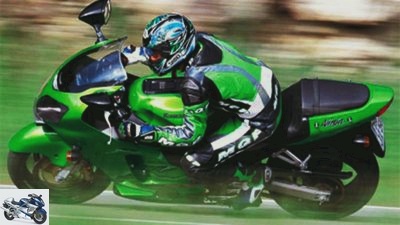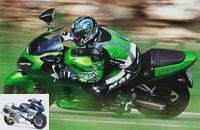Menus

Jahn
Top test Kawasaki ZX-12R
ZX-12Air
With its 175 hp engine, Kawasaki’s green racer bridges distances as if in flight and, if necessary, pushes the boundaries of time and space. If you travel with the 2001 model like on cloud nine or only in the direction of jet lag?
Clear announcement, Kawasaki’s ZX-12R should be the fastest, most stable and strongest in its class on its debut last year and bring Suzuki’s 300 km / h peregrine falcon Hayabusa down from the sky. With a promised 178 hp and 308 km / h documented in the vehicle registration, the Kawa jet should have sucked in Hayabusen and double Xen through the mighty Ram Air throat, hacked it in the 1199 cm³ engine and plucked it out of the titanic rear silencer. Unfortunately, small problems slowed the start, and then the supposed high-flyer in the MOTORRAD comparison test (9/2000) also had to bow to Honda’s smart double X and main rival Hayabusa. The reasons: hard load changes, half-baked driving behavior and the high price.
And now that: Since the beginning of 2001 is ?? electronically governed – at 299 km / h, the result of voluntary self-restraint. However, only the little boys from the neighborhood are really disappointed. When looking at the speedometer scale of the super ninja, they only yawn a tired “280” instead of the awesome “340” – right? like Daddy’s turbo diesel family carriage.
Well done, the ZX-12R won’t give up its air sovereignty over the regulars’ tables and highways that quickly. Despite the politically motivated mini-castration, the twelve is still a whole guy whose power already flashes when you slowly curl up: from 2500 rpm there are over 90 Newton meters available, beyond 3500 tours there is a three-digit dose of torque. The engine acts softly and, apart from a slight tingling sensation in the middle speed range, low-vibration. You roll through towns well in the sixth, even when overtaking maneuvers you can stay in high gear. Simply pull the cable briefly and, whoosh, the green one leaves behind everything that crawls and flies on public roads. Enjoying a beautifully motorized landscape, preferably far this side of the road traffic regulations: The row of four below and the comfortable, not exaggeratedly sporty arranged triangle of notches, handlebars and bench make it possible – the seating position pleases big and small pilots alike. The modified, smooth-running clutch and instruments with time and fuel gauge help in everyday life. The six-speed box is shirt-sleeved and loud as ever, but the steps lock reliably.
The driving behavior has developed positively. While the twelve tires, which were basically fitted with the Dunlop D 207 original equipment, fell out of favor due to their pronounced self-steering behavior, this phenomenon can only be felt rudimentarily in the test motorcycle despite the identical tires. Should Dunlop have tacitly responded to previous criticism? In any case, the fact is that the wide 200 mm skin on the rear wheel is still somewhat unwilling to follow the swiftly turning 120 mm front when changing lean angles, but this is far less noticeable than before? the phenomenon only becomes noticeable again as the tread depth decreases. Overall, the 249 kilogram ZX-12R has been scurrying smoothly around the corner with a 4.5 millimeter thick washer on the strut mount since the rear was lifted at the factory, but it still stands by its pounds in terms of handling and does not make any nimble curve fairy. Although she can also drive very tight turns. In those, however, the clear play in the drive train and the defused, but still rapid throttle response, which has been defused by means of a modified black box, causes dissonances.
The sensitively appealing fork and the hard but fair acting rear shock strut, both blessed with a very wide adjustment range and ample reserves, try to reconcile. The latter also has the front brake with six-piston calipers – nicely proportional to the hand force and relentlessly gripping when necessary. In contrast to the rear system, which is blunt and can hardly be dosed and only does its job according to regulations. It’s actually a shame, as is the fact that Kawasaki doesn’t have an anti-lock braking system.
Range? Well, on the country road, the Kawa approved 5.8 liter Super per 100 kilometers, so non-stop flights over 350 kilometers are possible – unless you let the preventive flashing LCD reserve display lure you to the gas station earlier. More than four liters splash in the metal bladder, which extends from the dummy tank to under the bench seat, when the warning is low. This form is possible and necessary because of the monocoque frame. A hollow body made of welded aluminum sheets spans over the engine between the steering head and the cast iron swing arm mounting. Stiffened by metal sheets and divided into several chambers, this also functions as an air filter box, so that the intake air can take course towards the injection system without any major detours. How well this works becomes clear from around 8000 rpm at the latest, as soon as the imaginary afterburner ignites and the up to then gentle but determined acceleration á la Charterjet turns into an almost violent catapult start ?? can only be enjoyed on the unlimited motorway.
There, beyond red-framed signs, the ninja can properly make the eyrie. When rebellious TDIs already hoist the white flag, the Kawa driver bored puts in fourth. That is always enough to show the rear end of even chauffeurs of powerful metal boxes. But only briefly, because the clock is more than 280 km / h in no time, and permanent companions are as rare as a lottery winner. It’s nice that driving the ZX-12R at high speed does not require any particular courage, stamina or other skills other than a little concentration on the surroundings. Excellent, turbulence-free wind protection as well as the straight-line stability, apart from the occasional pendulum, turn every pleasure stroller into a tough speed freak in the saddle of the Kawa, who, thanks to the Kawa floodlights, does not even have to be afraid of night operations. However, caution is required – even during the day – when accelerating fully beyond the 200 mark: Rapidly successive bumps make the front wheel twitch briefly and bring the pilot back into the disdainful reality of common single-track vehicles. The relatively high lift, despite the teasing wings, is likely to play a role here. In the MOTORRAD aerodynamics comparison (issue 16/2000), the ZX-12R definitely brought up the rear in this discipline, but was at the fore in terms of air resistance with a seated driver.
So it’s no wonder that speeds of 250 km / h – assuming low traffic density – become a comfortable cruising speed. It’s just a shame that trips like this are interrupted by a refueling stop about every 45 minutes, because around twelve liters per 100 kilometers rustle easily through the injection nozzles.
M.With the pillion passenger, the refueling stop is not unwelcome, because because of the high and too far forward rear pegs, passengers only travel wood class and even hardened test pillars have the feeling of falling overboard when accelerating. So rather like »Top Gun« Tom Cruise striving towards the sunset solo? whether overland or supersonic flight, the ZX-12Air is the right partner for both.
Buy complete article

Top test Kawasaki ZX-12R
ZX-12Air
Measurements
MOTORCYCLE measured valuesBraking and driving dynamicsBrake measurementBraking distance from 100 km / h 37.9 m Average braking deceleration 10.2 m / s² Comments: Dosage and effectiveness of the front brake at a very high level, with strong deceleration the rear becomes slightly restless. Rear braking system blunt and difficult to dose.Handling course I Best lap time 20.8 secvmax at the measuring point 98.1 km / h Comments: The awkwardness due to the high weight and corresponding steering forces is compensated by the powerful engine.Handling course II Best lap time 28.3 secvmax at Measuring point 54.1 km / h Comments: Despite high directional stability in long S-curves, the Kawa allows a tight curve at the turning point. The only disturbing factor here are the strong load changes.Circular orbit O 46 mBest lap time 11.2 secvmax at the measuring point 52.9 km / h Comments: Good stability on an undulating track, footpegs only touch down even when driving with a passenger in an extremely inclined position. Slight understeer.
Conclusion
After its somewhat unfortunate start, the performance man from Kawasaki has blossomed into a real big bike alternative in the 2001 trim, in the MOTORRAD top test so far only just beaten by a Honda CBR 1100 XX or Yamaha FJR 1300. Softer responsiveness and improved handling increase the fun on the country road, on the highway the Ninja is and will be the boss anyway.
News & Facts
EngineModified black box, maximum speed electronically limited to 298 km / hRelease bearing and clutch springs revised EquipmentUpright shaped upper cover part with new attachment points for the mirrorsWide speedometer scale with maximum display 280 km / h plus marking linesPlusMirror box with a good field of visionLight range adjustment by handwheel Chassis settings (for comfortable solo operation) Fork: spring base six rings visible, rebound stage two clicks on, compression stage ten clicks on spring strut: spring base spring length 173 millimeters, rebound stage five clicks on, compression stage 17 clicks on
Related articles
-
Art Top-Test Kawasaki ZZR 1400 The time machine Welcome to the future. The ZZR 1400 is said to be the first production bike in the world with 200 hp …
-
Gargolov Top-Test Kawasaki ZZ-R 1200 Wuchtbrumme A sports tourer, mighty, strong, carved from the solid: the Kawasaki ZZ-R 1200. Certainly not …
-
Jahn Top test Kawasaki ZRX 1200 R Greetings from Eddie The Kawasaki tradition of the strong in-line four-cylinder is not embodied as emphatically as the…
-
Kawasaki Z 900 RS (2018) in the test
Jacek Bilski 23 pictures bilski-fotografie.de 1/23 Kawasaki Z 900 RS: technology from the Z 900, style based on the epoch-making Z1. bilski-fotografie.de 2/23 wide, …
-
Kawasaki Z 800 in the top test
j.kuenstle.de 15 pictures 1/15 The Kawasaki Z 800 is the successor to the Z 750 and in the MOTORRAD top test. 2/15 Wheelie with the …
-
Comparison test Kawasaki Z 900, MV Agusta Brutale 800 RR Yamaha MT-09 SP
fact / Joachim Schahl 21 pictures fact / Joachim Schahl 1/21 Kawasaki Z 900, MV Agusta Brutale 800 RR and Yamaha MT-09 SP promise undisguised driving pleasure …
-
BMW K 1200 S against Honda CBR 1100 XX, Kawasaki ZX-12R and Suzuki Hayabusa
fact BMW K 1200 S against Honda CBR 1100 XX, Kawasaki ZX-12R and Suzuki Hayabusa The strongest temptation Since BMW motorcycles have existed, the K 1200 S, a …
-
Artist Review Kawasaki ZX-12R Grand Tourismo Kawasaki is setting itself up permanently in the high-horsepower class. For sports fans there is the ZX-10R,…
-
Honda, Kawasaki, KTM, Suzuki and Yamaha Crosser in the test
Honda Comparison test: Motocross MX2 (up to 250 cm³) Crossers from Honda, Kawasaki, KTM, Suzuki and Yamaha in the test The Suzuki RM-Z 250 has dominated…
-
Kawasaki ZX-10R and BMW S 1000 RR in a comparison test
www.bilski-fotografie.de 25 pictures www.bilski-fotografie.de 1/25 Let’s first take a look at the new Kawasaki ZX-10R. www.bilski-fotografie.de …